inflation pressure Alfa Romeo MiTo 2014 Owner's Manual
[x] Cancel search | Manufacturer: ALFA ROMEO, Model Year: 2014, Model line: MiTo, Model: Alfa Romeo MiTo 2014Pages: 280, PDF Size: 8.79 MB
Page 111 of 280
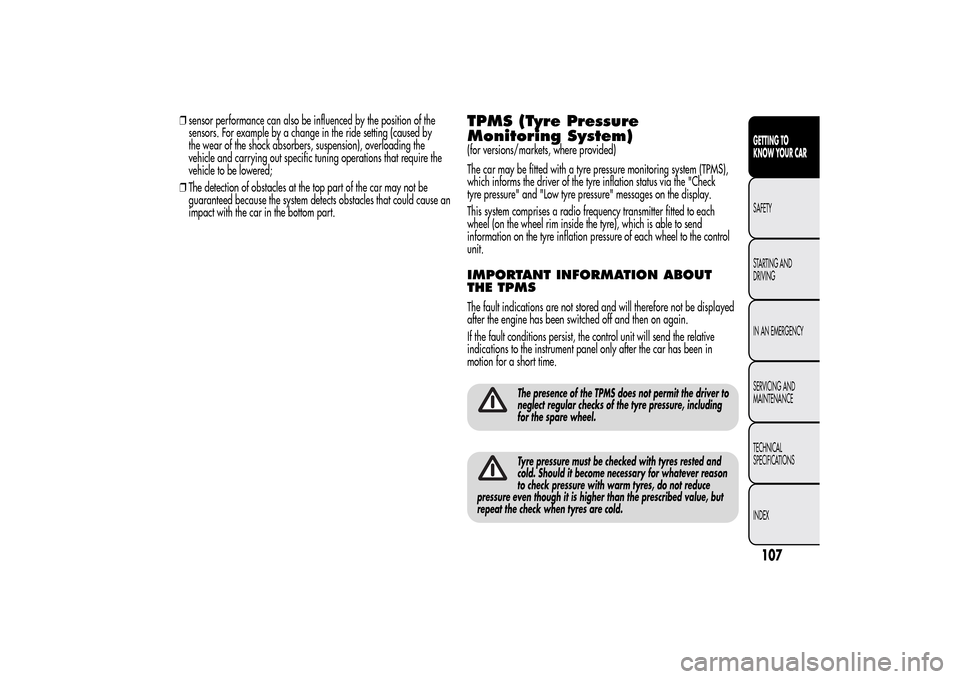
❒sensor performance can also be influenced by the position of the
sensors. For example by a change in the ride setting (caused by
the wear of the shock absorbers, suspension), overloading the
vehicle and carrying out specific tuning operations that require the
vehicle to be lowered;
❒The detection of obstacles at the top part of the car may not be
guaranteed because the system detects obstacles that could cause an
impact with the car in the bottom part.
TPMS (Tyre Pressure
Monitoring System)(for versions/markets, where provided)
The car may be fitted with a tyre pressure monitoring system (TPMS),
which informs the driver of the tyre inflation status via the "Check
tyre pressure" and "Low tyre pressure" messages on the display.
This system comprises a radio frequency transmitter fitted to each
wheel (on the wheel rim inside the tyre), which is able to send
information on the tyre inflation pressure of each wheel to the control
unit.IMPORTANT INFORMATION ABOUT
THE TPMSThe fault indications are not stored and will therefore not be displayed
after the engine has been switched off and then on again.
If the fault conditions persist, the control unit will send the relative
indications to the instrument panel only after the car has been in
motion for a short time.
The presence of the TPMS does not permit the driver to
neglect regular checks of the tyre pressure, including
for the spare wheel.Tyre pressure must be checked with tyres rested and
cold. Should it become necessary for whatever reason
to check pressure with warm tyres, do not reduce
pressure even though it is higher than the prescribed value, but
repeat the check when tyres are cold.
107GETTING TO
KNOW YOUR CARSAFETY
STARTING AND
DRIVING
IN AN EMERGENCY
SERVICING AND
MAINTENANCE
TECHNICAL
SPECIFICATIONS
INDEX
Page 112 of 280
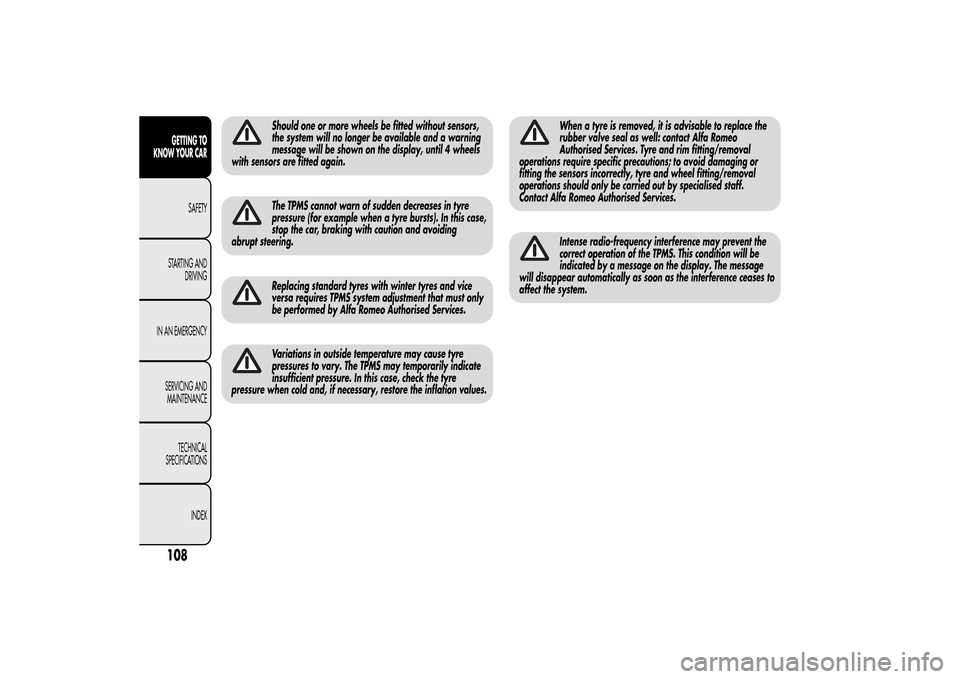
Should one or more wheels be fitted without sensors,
the system will no longer be available and a warning
message will be shown on the display, until 4 wheels
with sensors are fitted again.The TPMS cannot warn of sudden decreases in tyre
pressure (for example when a tyre bursts). In this case,
stop the car, braking with caution and avoiding
abrupt steering.Replacing standard tyres with winter tyres and vice
versa requires TPMS system adjustment that must only
be performed by Alfa Romeo Authorised Services.Variations in outside temperature may cause tyre
pressures to vary. The TPMS may temporarily indicate
insufficient pressure. In this case, check the tyre
pressure when cold and, if necessary, restore the inflation values.
When a tyre is removed, it is advisable to replace the
rubber valve seal as well: contact Alfa Romeo
Authorised Services. Tyre and rim fitting/removal
operations require specific precautions; to avoid damaging or
fitting the sensors incorrectly, tyre and wheel fitting/removal
operations should only be carried out by specialised staff.
Contact Alfa Romeo Authorised Services.Intense radio-frequency interference may prevent the
correct operation of the TPMS. This condition will be
indicated by a message on the display. The message
will disappear automatically as soon as the interference ceases to
affect the system.
108GETTING TO
KNOW YOUR CAR
SAFETY
STARTING AND
DRIVING
IN AN EMERGENCY
SERVICING AND
MAINTENANCE
TECHNICAL
SPECIFICATIONS
INDEX
Page 144 of 280
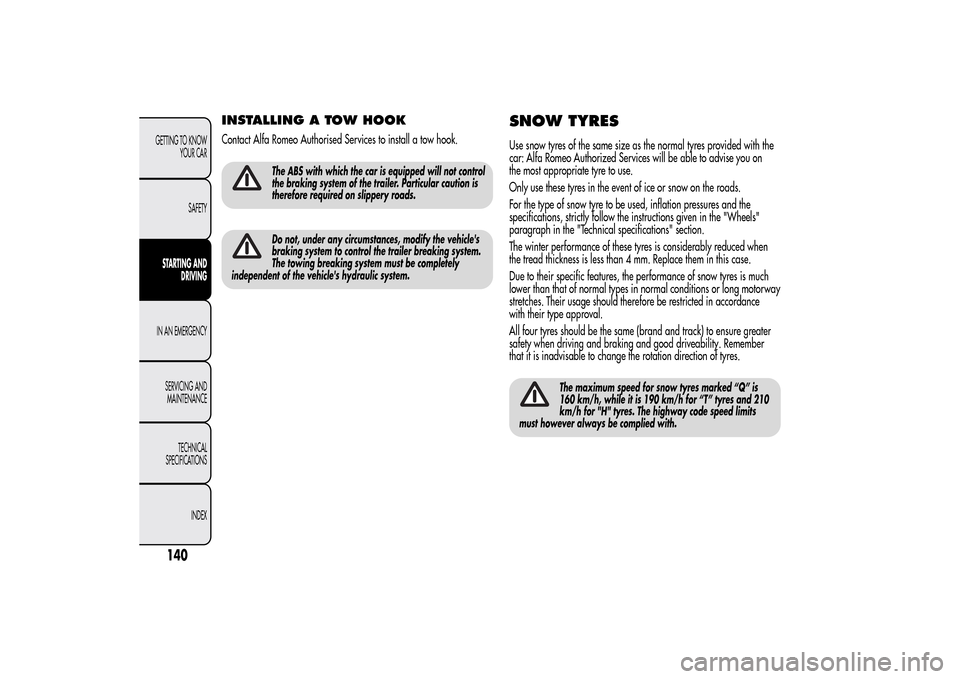
INSTALLING A TOW HOOKContact Alfa Romeo Authorised Services to install a tow hook.
The ABS with which the car is equipped will not control
the braking system of the trailer. Particular caution is
therefore required on slippery roads.Do not, under any circumstances, modify the vehicle's
braking system to control the trailer breaking system.
The towing breaking system must be completely
independent of the vehicle's hydraulic system.
SNOW TYRESUse snow tyres of the same size as the normal tyres provided with the
car: Alfa Romeo Authorized Services will be able to advise you on
the most appropriate tyre to use.
Only use these tyres in the event of ice or snow on the roads.
For the type of snow tyre to be used, inflation pressures and the
specifications, strictly follow the instructions given in the "Wheels"
paragraph in the "Technical specifications" section.
The winter performance of these tyres is considerably reduced when
the tread thickness is less than 4 mm. Replace them in this case.
Due to their specific features, the performance of snow tyres is much
lower than that of normal types in normal conditions or long motorway
stretches. Their usage should therefore be restricted in accordance
with their type approval.
All four tyres should be the same (brand and track) to ensure greater
safety when driving and braking and good driveability. Remember
that it is inadvisable to change the rotation direction of tyres.
The maximum speed for snow tyres marked “Q” is
160 km/h, while it is 190 km/h for “T” tyres and 210
km/h for "H" tyres. The highway code speed limits
must however always be complied with.
140GETTING TO KNOW
YOUR CAR
SAFETYSTARTING AND
DRIVINGIN AN EMERGENCY
SERVICING AND
MAINTENANCE
TECHNICAL
SPECIFICATIONS
INDEX
Page 148 of 280

The vehicle's driving characteristics will be modified
with the space-saver wheel fitted. Avoid violent
acceleration and braking, sharp steering and fast
cornering. The total life of a space-saver wheel is approximately
3,000 km, after which it must be replaced by another wheel of
the same type. Never attempt to fit a conventional tyre on a rim
designed for use as a space-saver wheel. Repair and refit the
standard wheel as soon as possible. Two or more space-saver
wheels should never be used together. Do not grease the threads
of bolts before fitting them: they might slip out.The jack provided is only intended to be used for
replacing tyres on the vehicle with which it is supplied,
or on same-model vehicles. Never use the jack for
other purposes, such as lifting other car models. Never use it for
repair operations under the vehicle. Incorrect positioning of the
jack may cause the car to fall. Do not use the jack for loads
higher than those shown on the label. Never install snow chains
on the small spare wheel; if a front tyre (driving wheel) is
punctured and you need to use snow chains, use a standard
wheel from the rear axle and install the small spare wheel on the
rear axle. In this way, with two normal front drive wheels, it is
possible to use snow chains.Incorrectly fitting the hubcap may cause it to fall off
when the vehicle is in motion. Never tamper with the
inflating valve. Never introduce tools of any kind
between rim and tyre. Regularly check the inflation pressure of
the tyres and space-saver wheel (see chapter "Technical
specifications").
JACKPlease note that:
❒the jack weight is 1.76 kg;
❒the jack requires no adjustment;
❒the jack cannot be repaired and in the event of a fault it must be
replaced by another original one;
❒no tool other than its cranking device may be fitted on the jack.
To change a wheel proceed as follows:
❒stop the car in a position that is not dangerous for oncoming traffic
where you can change the wheel safely. The ground must be flat
and sufficiently compact;
❒switch off the engine, pull up the handbrake and engage 1
agear or
reverse; put on the high visibility jacket (required by law) before
leaving the vehicle;
❒open the luggage compartment, pull tab A fig. 114 and lift up the
mat;
fig. 114
A0J0104
144GETTING TO KNOW
YOUR CAR
SAFETY
STARTING AND
DRIVING
IN AN
EMERGENCY
SERVICING AND
MAINTENANCE
TECHNICAL
SPECIFICATIONS
INDEX
Page 154 of 280

Never operate the compressor for longer than 20
consecutive minutes. Risk of overheating. The kit is not
suitable for definitive repairs, so the repaired tyres
may only be used temporarily.Dispose of the bottle and the sealant liquid properly. Have
the sealing fluid and the cylinder disposed of in compliance
with national and local regulations.The bottle contains ethylene glycol and latex: it may
cause an allergic reaction. It is harmful if swallowed. It
is irritant for the eyes in case of contact. There could
be a reaction in the event of inhalation or contact. Avoid contact
with the eyes, skin and clothes. In the event of contact, rinse
immediately with plenty of water. If ingested, do not induce
vomiting. Rinse out your mouth, drink large quantities of water
and seek immediate medical attention. Keep out of the reach
of children. The product must not be used by asthmatics. Do not
inhale the vapours during insertion and suction. Call a doctor
immediately if allergic reactions are noted. Store the bottle in the
specific compartment, away from sources of heat. The sealant
fluid has an expiry date. Replace the bottle containing out-of-
date sealant fluid.
INFLATION PROCEDURE
Wear the protective gloves provided with the kit.
Proceed as follows:
❒engage the handbrake, unscrew the tyre valve cap, take out the
flexible filler pipe A fig. 127 and tighten the ring nut B on the tyre
valve;
❒make sure that switch A fig. 128 for the compressor is in position 0
(off), start the engine, insert the plug A fig. 129 into the power
socket on the central tunnel and switch on the compressor by
bringing switch A fig. 128 to position I (on);
❒inflate the tyre to the pressure indicated in the “Wheels” paragraph
in the “Technical specifications” section. In order to obtain a more
precise reading, check the pressure value on pressure gauge B
fig. 128 with the compressor off;
❒if after five minutes it is still impossible to reach at least 1.8 bar,
disengage the compressor from the valve and power socket, then
move the car forwards by approx. ten metres in order to distribute
the sealing fluid inside the tyre evenly, then repeat the inflation
operation;
fig. 127
A0J0214
150GETTING TO KNOW
YOUR CAR
SAFETY
STARTING AND
DRIVING
IN AN
EMERGENCY
SERVICING AND
MAINTENANCE
TECHNICAL
SPECIFICATIONS
INDEX
Page 182 of 280
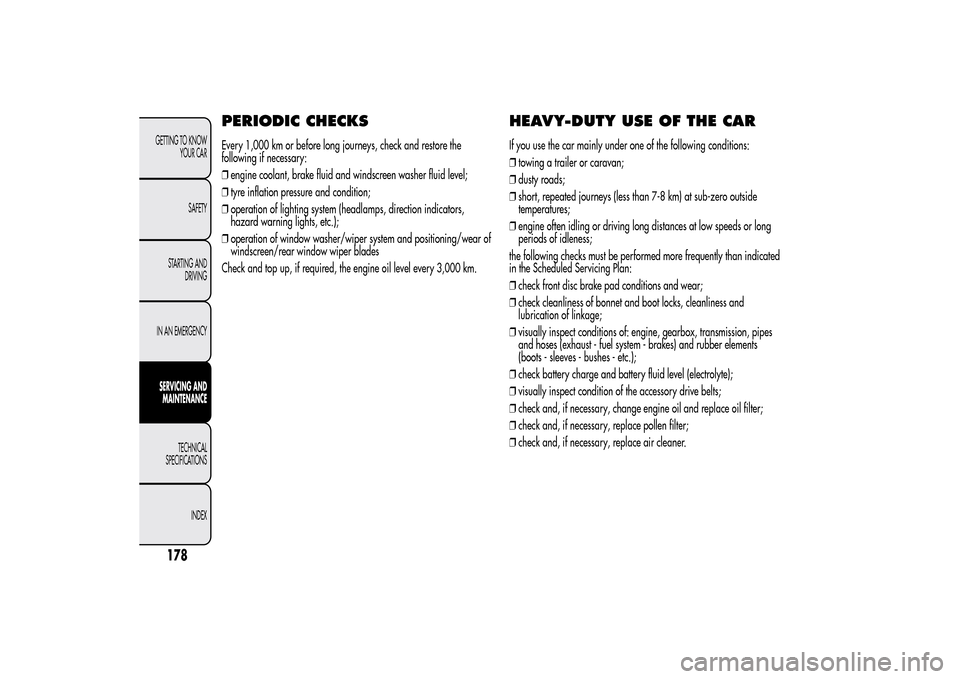
PERIODIC CHECKSEvery 1,000 km or before long journeys, check and restore the
following if necessary:
❒engine coolant, brake fluid and windscreen washer fluid level;
❒tyre inflation pressure and condition;
❒operation of lighting system (headlamps, direction indicators,
hazard warning lights, etc.);
❒operation of window washer/wiper system and positioning/wear of
windscreen/rear window wiper blades
Check and top up, if required, the engine oil level every 3,000 km.
HEAVY-DUTY USE OF THE CARIf you use the car mainly under one of the following conditions:
❒towing a trailer or caravan;
❒dusty roads;
❒short, repeated journeys (less than 7-8 km) at sub-zero outside
temperatures;
❒engine often idling or driving long distances at low speeds or long
periods of idleness;
the following checks must be performed more frequently than indicated
in the Scheduled Servicing Plan:
❒check front disc brake pad conditions and wear;
❒check cleanliness of bonnet and boot locks, cleanliness and
lubrication of linkage;
❒visually inspect conditions of: engine, gearbox, transmission, pipes
and hoses (exhaust - fuel system - brakes) and rubber elements
(boots - sleeves - bushes - etc.);
❒check battery charge and battery fluid level (electrolyte);
❒visually inspect condition of the accessory drive belts;
❒check and, if necessary, change engine oil and replace oil filter;
❒check and, if necessary, replace pollen filter;
❒check and, if necessary, replace air cleaner.
178GETTING TO KNOW
YOUR CAR
SAFETY
STARTING AND
DRIVING
IN AN EMERGENCYSERVICING AND
MAINTENANCE
TECHNICAL
SPECIFICATIONS
INDEX
Page 193 of 280

WHEELS AND TYRESBefore embarking on a long trip, and every two weeks, check the tyre
inflation pressure and space-saver wheel. Check the tyres when cold.
While driving the car, the pressure increases under standard
conditions: for the correct tyre inflation pressure, see "Wheels"
paragraph in the "Technical specifications" chapter.
Incorrect pressure causes abnormal tyre wear fig. 164:
A normal pressure: tread evenly worn;
B low pressure: tread particularly worn at the edges;
C high pressure: tread particularly worn in the centre.
The tyres must be replaced when the tread is less than 1.6 mm thick.
IMPORTANT
Take the following precautions to prevent damage to the tyres:
❒avoid braking suddenly, racing starts and violent impact against the
curb, potholes or other obstacles and driving for extended periods
on uneven road surfaces;❒periodically check that the tyres have no cuts in the side wall,
abnormal swelling or irregular tyre wear;
❒avoid travelling with the car overloaded. If you puncture a tyre, stop
immediately and replace it;
❒change the position of the tyres every 10-15 thousand kilometres,
keeping them on the same side of the car to avoid inverting the
direction of rotation;
❒tyres age even if they are not used much. Cracks in the tread and on
the sidewalls are a sign of ageing. Have the tyres checked by
specialised personnel if they have been fitted for longer than 6
years. Remember to check the space-saver wheel very carefully;
❒In the case of replacement, always fit new tyres, avoiding those of
dubious origin;
❒if a tyre is replaced, also replace the inflation valve.
Remember that the road holding qualities of your car
also depend on the correct inflation pressure of the
tyres.If the pressure is too low the tyre overheats and can be
seriously damaged.Do not cross switch the tyres, moving them from the
right of the car to the left and vice versa.
fig. 164
A0J0136
189GETTING TO KNOW
YOUR CAR
SAFETY
STARTING AND
DRIVING
IN AN EMERGENCYSERVICING AND
MAINTENANCETECHNICAL
SPECIFICATIONS
INDEX
Page 218 of 280
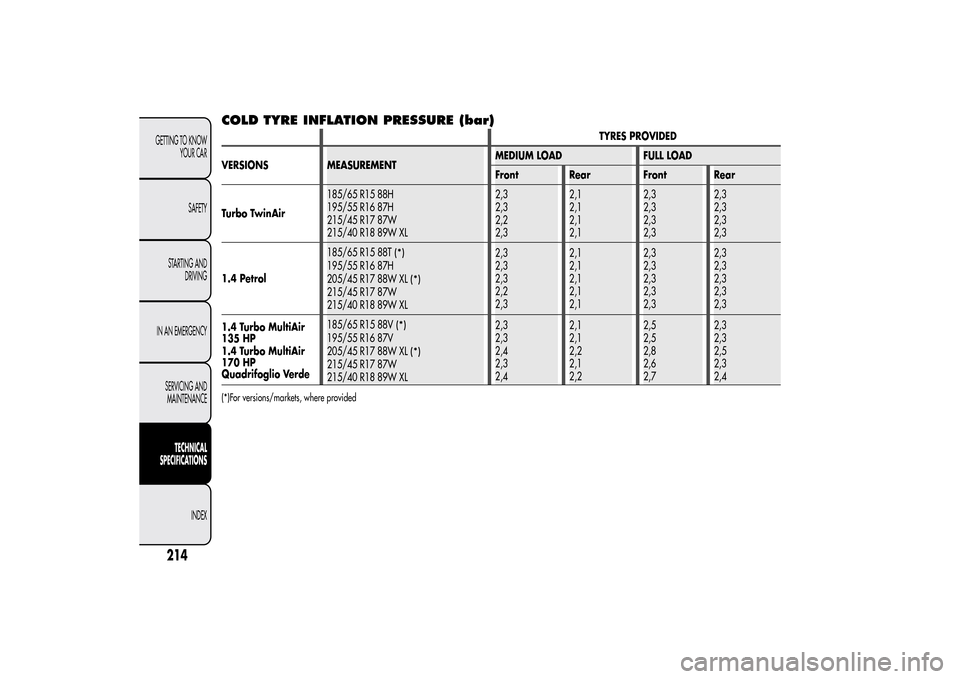
COLD TYRE INFLATION PRESSURE (bar)
TYRES PROVIDED
VERSIONS MEASUREMENTMEDIUM LOAD FULL LOAD
Front Rear Front Rear
Turbo TwinAir185/65 R15 88H
195/55 R16 87H
215/45 R17 87W
215/40 R18 89W XL2,3
2,3
2,2
2,32,1
2,1
2,1
2,12,3
2,3
2,3
2,32,3
2,3
2,3
2,3
1.4 Petrol185/65 R15 88T
(*)
195/55 R16 87H
205/45 R17 88W XL
(*)
215/45 R17 87W
215/40 R18 89W XL2,3
2,3
2,3
2,2
2,32,1
2,1
2,1
2,1
2,12,3
2,3
2,3
2,3
2,32,3
2,3
2,3
2,3
2,3
1.4 Turbo MultiAir
135 HP
1.4 Turbo MultiAir
170 HP
Quadrifoglio Verde185/65 R15 88V
(*)
195/55 R16 87V
205/45 R17 88W XL
(*)
215/45 R17 87W
215/40 R18 89W XL2,3
2,3
2,4
2,3
2,42,1
2,1
2,2
2,1
2,22,5
2,5
2,8
2,6
2,72,3
2,3
2,5
2,3
2,4
(*)For versions/markets, where provided
214GETTING TO KNOW
YOUR CAR
SAFETY
STARTING AND
DRIVING
IN AN EMERGENCY
SERVICING AND
MAINTENANCE
TECHNICAL
SPECIFICATIONS
INDEX
Page 219 of 280
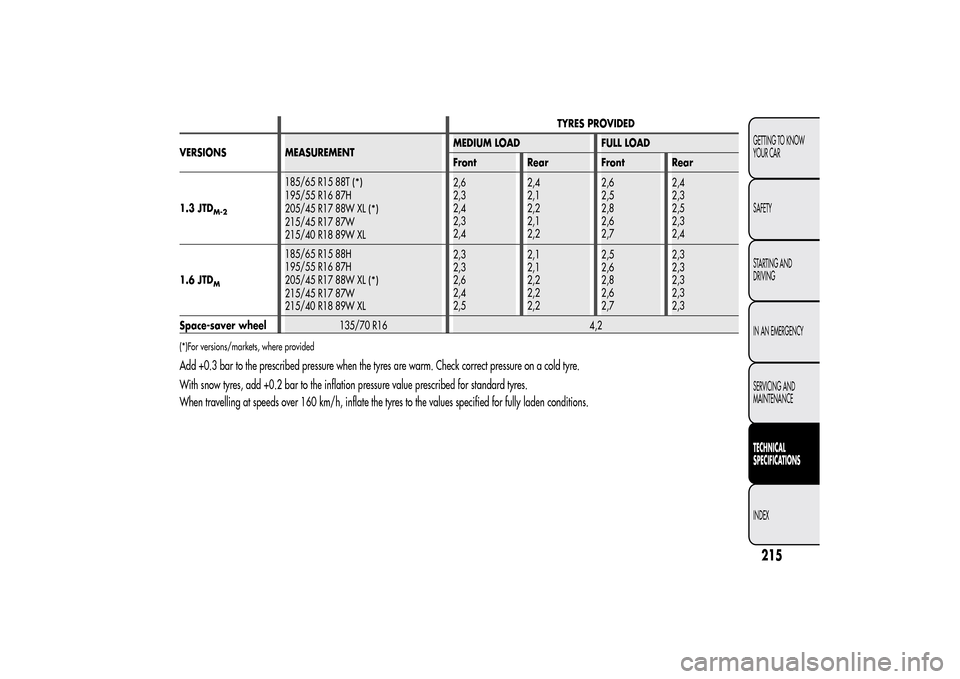
TYRES PROVIDED
VERSIONS MEASUREMENTMEDIUM LOAD FULL LOAD
Front Rear Front Rear
1.3 JTD
M-2
185/65 R15 88T
(*)
195/55 R16 87H
205/45 R17 88W XL
(*)
215/45 R17 87W
215/40 R18 89W XL2,6
2,3
2,4
2,3
2,42,4
2,1
2,2
2,1
2,22,6
2,5
2,8
2,6
2,72,4
2,3
2,5
2,3
2,4
1.6 JTD
M
185/65 R15 88H
195/55 R16 87H
205/45 R17 88W XL
(*)
215/45 R17 87W
215/40 R18 89W XL2,3
2,3
2,6
2,4
2,52,1
2,1
2,2
2,2
2,22,5
2,6
2,8
2,6
2,72,3
2,3
2,3
2,3
2,3
Space-saver wheel135/70 R16 4,2
(*)For versions/markets, where providedAdd +0.3 bar to the prescribed pressure when the tyres are warm. Check correct pressure on a cold tyre.
With snow tyres, add +0.2 bar to the inflation pressure value prescribed for standard tyres.
When travelling at speeds over 160 km/h, inflate the tyres to the values specified for fully laden conditions.
215GETTING TO KNOW
YOUR CAR
SAFETY
STARTING AND
DRIVING
IN AN EMERGENCY
SERVICING AND
MAINTENANCETECHNICAL
SPECIFICATIONSINDEX
Page 276 of 280
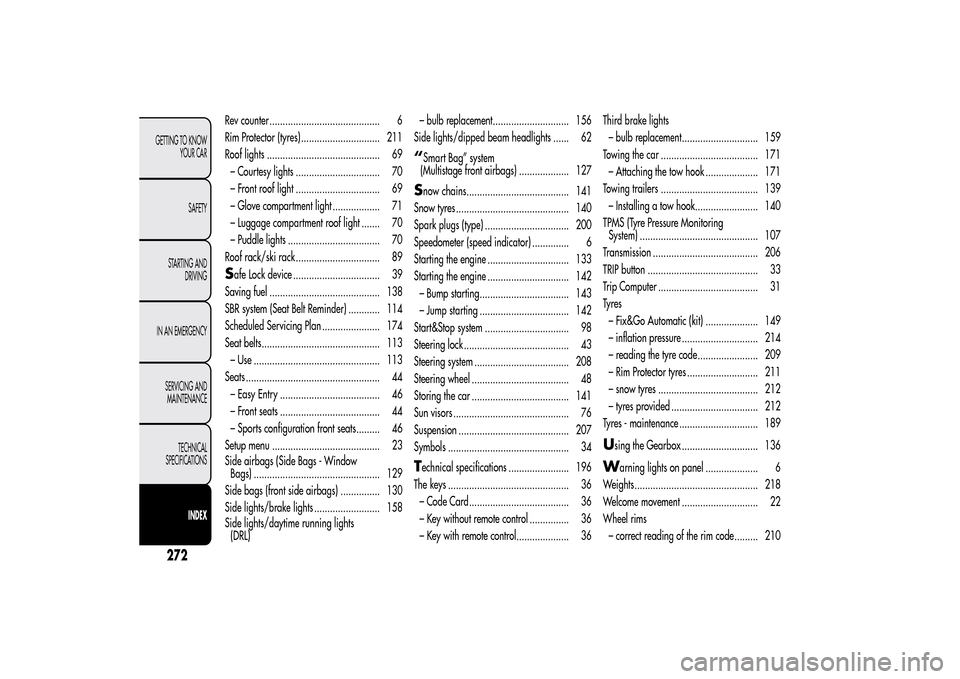
Rev counter .......................................... 6
Rim Protector (tyres) .............................. 211
Roof lights ........................................... 69
– Courtesy lights ................................ 70
– Front roof light ................................ 69
– Glove compartment light .................. 71
– Luggage compartment roof light ....... 70
– Puddle lights ................................... 70
Roof rack/ski rack ................................ 89Safe Lock device ................................. 39
Saving fuel .......................................... 138
SBR system (Seat Belt Reminder) ............ 114
Scheduled Servicing Plan ...................... 174
Seat belts............................................. 113
– Use ................................................ 113
Seats ................................................... 44
– Easy Entry ...................................... 46
– Front seats ...................................... 44
– Sports configuration front seats......... 46
Setup menu ......................................... 23
Side airbags (Side Bags - Window
Bags) ................................................ 129
Side bags (front side airbags) ............... 130
Side lights/brake lights ......................... 158
Side lights/daytime running lights
(DRL)– bulb replacement............................. 156
Side lights/dipped beam headlights ...... 62
“Smart Bag” system
(Multistage front airbags) ................... 127Snow chains....................................... 141
Snow tyres ........................................... 140
Spark plugs (type) ................................ 200
Speedometer (speed indicator) .............. 6
Starting the engine ............................... 133
Starting the engine ............................... 142
– Bump starting.................................. 143
– Jump starting .................................. 142
Start&Stop system ................................ 98
Steering lock ........................................ 43
Steering system .................................... 208
Steering wheel ..................................... 48
Storing the car ..................................... 141
Sun visors ............................................ 76
Suspension .......................................... 207
Symbols .............................................. 34Technical specifications ....................... 196
The keys .............................................. 36
– Code Card...................................... 36
– Key without remote control ............... 36
– Key with remote control.................... 36Third brake lights
– bulb replacement............................. 159
Towing the car ..................................... 171
– Attaching the tow hook .................... 171
Towing trailers ..................................... 139
– Installing a tow hook........................ 140
TPMS (Tyre Pressure Monitoring
System) ............................................. 107
Transmission ........................................ 206
TRIP button .......................................... 33
Trip Computer ...................................... 31
Ty r e s
– Fix&Go Automatic (kit) .................... 149
– inflation pressure ............................. 214
– reading the tyre code....................... 209
– Rim Protector tyres ........................... 211
– snow tyres ...................................... 212
– tyres provided ................................. 212
Tyres - maintenance .............................. 189
U
sing the Gearbox ............................. 136
W
arning lights on panel .................... 6
Weights............................................... 218
Welcome movement ............................. 22
Wheel rims
– correct reading of the rim code ......... 210
27GETTING TO KNOW
YOUR CAR
SAFETY
STARTING AND
DRIVING
IN AN EMERGENCY
SERVICING AND
MAINTENANCE
TECHNICAL
SPECIFICATIONS
INDEX2